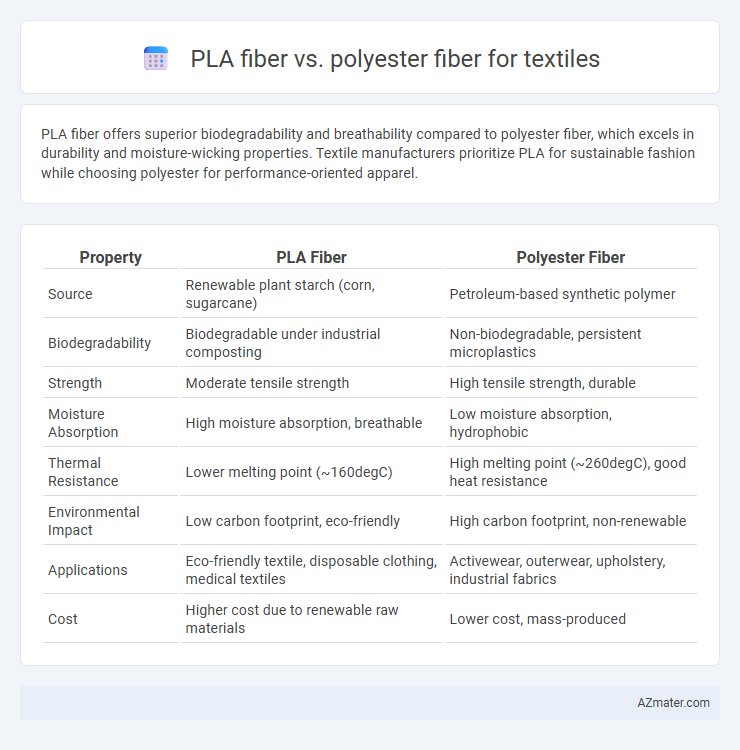PLA fiber offers superior biodegradability and breathability compared to polyester fiber, which excels in durability and moisture-wicking properties. Textile manufacturers prioritize PLA for sustainable fashion while choosing polyester for performance-oriented apparel.
Table of Comparison
| Property | PLA Fiber | Polyester Fiber |
|---|---|---|
| Source | Renewable plant starch (corn, sugarcane) | Petroleum-based synthetic polymer |
| Biodegradability | Biodegradable under industrial composting | Non-biodegradable, persistent microplastics |
| Strength | Moderate tensile strength | High tensile strength, durable |
| Moisture Absorption | High moisture absorption, breathable | Low moisture absorption, hydrophobic |
| Thermal Resistance | Lower melting point (~160degC) | High melting point (~260degC), good heat resistance |
| Environmental Impact | Low carbon footprint, eco-friendly | High carbon footprint, non-renewable |
| Applications | Eco-friendly textile, disposable clothing, medical textiles | Activewear, outerwear, upholstery, industrial fabrics |
| Cost | Higher cost due to renewable raw materials | Lower cost, mass-produced |
Introduction to PLA and Polyester Fibers
PLA fiber, derived from renewable resources like corn starch or sugarcane, offers biodegradability and low environmental impact compared to traditional synthetic fibers. Polyester fiber, a widely used synthetic material made from petrochemicals, is known for its strength, durability, and moisture-wicking properties in textile applications. PLA fibers prioritize sustainability and compostability, while polyester fibers excel in performance and cost-efficiency for large-scale textile production.
Composition and Manufacturing Processes
PLA fiber, derived from renewable resources such as corn starch or sugarcane, is composed primarily of polylactic acid through a bio-based polymerization process. Polyester fiber, a synthetic polymer made from petroleum-derived polyethylene terephthalate (PET), is produced via a melt spinning process involving polymerization, extrusion, and solidification. The manufacturing of PLA fiber emphasizes eco-friendly, biodegradable materials, whereas polyester fiber production relies on petrochemical processes resulting in durable, non-biodegradable textiles.
Environmental Impact and Sustainability
PLA fiber, derived from renewable resources like corn starch, offers significant environmental benefits over polyester fiber, which is petroleum-based and contributes to fossil fuel depletion. PLA fiber is biodegradable under industrial composting conditions, reducing plastic pollution and landfill accumulation typical with polyester textiles. Textile manufacturers favor PLA for its lower carbon footprint and reduced reliance on non-renewable resources, promoting sustainability in eco-conscious apparel production.
Biodegradability and End-of-Life Disposal
PLA fiber, derived from renewable resources like corn starch, offers superior biodegradability compared to petroleum-based polyester fiber, breaking down effectively in industrial composting environments within 6 to 12 months. Polyester fiber, while durable and widely used in textiles, is non-biodegradable and can persist in landfills or oceans for hundreds of years, contributing to microplastic pollution. End-of-life disposal of PLA fiber is more environmentally friendly due to its compostable nature, whereas polyester often requires energy-intensive recycling or leads to long-term waste accumulation.
Physical and Mechanical Properties
PLA fiber exhibits higher moisture regain and biodegradability compared to polyester fiber, making it more environmentally friendly for textile applications. Polyester fiber outperforms PLA in tensile strength, elongation, and durability, providing superior mechanical properties for high-performance fabrics. Both fibers offer distinct advantages, with PLA favoring sustainability and polyester excelling in long-term wear resistance.
Performance in Textile Applications
PLA fiber offers superior moisture-wicking properties and biodegradability compared to polyester fiber, making it ideal for eco-friendly textile applications. Polyester fiber provides higher tensile strength and better abrasion resistance, ensuring durability in high-performance garments. Both fibers exhibit excellent dimensional stability, but PLA excels in comfort and breathability due to its natural origin.
Comfort and Skin Friendliness
PLA fiber derived from renewable resources offers excellent moisture-wicking properties and breathability, enhancing comfort by keeping skin dry and cool. Polyester fiber provides durability and wrinkle resistance but tends to trap heat and moisture, which may cause discomfort and irritation for sensitive skin. Skin friendliness favors PLA fiber due to its natural origin and hypoallergenic characteristics, making it suitable for sensitive or allergy-prone users.
Dyeability and Color Fastness
PLA fiber exhibits superior dyeability due to its natural affinity for reactive and acid dyes, resulting in vibrant and uniform coloration compared to polyester fiber. Polyester fiber typically requires disperse dyes applied at high temperatures, which can limit color penetration and lead to less vivid hues. In terms of color fastness, polyester fibers generally outperform PLA fibers, offering excellent resistance to washing, light, and perspiration, whereas PLA fibers may experience moderate fading under similar conditions.
Cost and Market Availability
PLA fiber, derived from renewable resources like corn starch, generally costs more than polyester fiber due to its bio-based production process and lower economies of scale. Polyester fiber dominates the textile market with widespread availability and mature manufacturing infrastructure, resulting in lower prices and extensive supply chains. Despite higher costs, PLA fibers appeal to eco-conscious brands, while polyester remains preferred for cost-effective mass production.
Future Prospects and Industry Trends
PLA fiber, derived from renewable resources like corn starch, is gaining significant attention due to its biodegradability and lower carbon footprint compared to conventional polyester fiber made from petrochemicals. The textile industry is increasingly adopting PLA fiber as sustainability regulations tighten and consumer demand for eco-friendly products rises, positioning it as a promising alternative in future fabric innovations. Advances in PLA fiber durability and blending technologies are set to enhance performance, expanding its application scope and driving market growth alongside the well-established polyester sector.

Infographic: PLA fiber vs Polyester fiber for Textile
 azmater.com
azmater.com